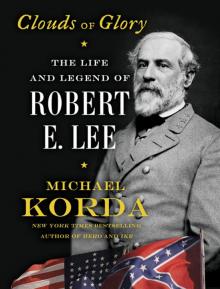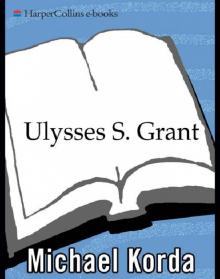- Home
- Michael Korda
Clouds of Glory Page 32
Clouds of Glory Read online
Page 32
The second incident involved the Norfolk Navy Yard. It had been seized by Confederate troops, then swiftly recaptured in a daring raid from the sea during which Union troops set fire to most of the ships and the yards, then steamed off with one of the naval vessels in tow—an early and embarrassing demonstration of Union naval strength. On the positive side over 1,000 stored naval guns and nearly 3,000 barrels of gunpowder were saved, and many of the guns could be mounted on carriages and used as artillery on land—but the loss of the ships was a grave blow. Several of them would be rebuilt from the waterline up, and the hulk of one of them, the steam frigate U.S.S. Merrimack, would eventually be converted into the Confederate ironclad Virginia, and do battle against the Union ironclad Monitor in March 1862.
Lincoln’s reaction to the firing on Fort Sumter had been to issue “A Proclamation” on April 15, calling forth “the militia of the several States of the Union, to the aggregate total of seventy-five thousand . . . to cause the laws to be duly executed.” This was the army whose command Lee had been offered on April 18. Describing “the present condition of public affairs” as “an extraordinary occasion,” the president commanded the rebels “to disperse, and retire peaceably to their respective abodes within twenty days of this date.” By design Lincoln’s proclamation was something less than a declaration of war, but it seemed to suggest that on, or shortly after, May 5 the Federal government would take military action against those states which had seceded. This gave Lee less than two weeks to prepare for the defense of Virginia against what he supposed would be overwhelming forces. Events were moving at a dizzying pace. The bombardment of Fort Sumter began on April 12, three days later, on April 15, Lincoln released his proclamation calling up 75,000 men; on April 18 Lee was offered command of the new Union Army that was being called up; early on April 19 he resigned from the U.S. Army; on April 22 he left Arlington forever and took the train for Richmond with Judge Robertson; and on April 23 he was already in command of the armed forces of Virginia, with just twelve days to go before the deadline in the president’s proclamation took effect.
Lee immediately set about transforming chaos into the makings of an effective military machine. He quickly put together a personal staff (perhaps its most important member would be young Walter Herron Taylor, a graduate of Virginia Military Institute who would remain with Lee throughout the war) and to dexterously replace inept or elderly senior militia officers (most of them possessed of varying degrees of local political clout) with experienced officers. He drew up plans to gather arms from wherever he could, and to designate railway junctions throughout the state where militia companies could be mustered and armed under the command of an experienced officer and instructed in drill by cadets chosen from VMI. He made a personal inspection of the defenses at Harpers Ferry and Norfolk, and set everyone to digging the fieldworks at which he was the acknowledged expert. He soon established a training depot near Richmond, nicknamed Camp Lee, to turn civilian volunteers into soldiers. Lee amazed everyone by his energy and professional skill, putting together in a matter of weeks an army of “40,000 troops [and] one-hundred fifteen field artillery pieces,” as well as a group of officers many of whom would be among the South’s leading generals—including Thomas J. (“Stonewall”) Jackson; John Bell Hood, Lee’s companion from Camp Cooper, Texas; and John B. Magruder.
Lee was always aware that only a few miles north, in the Union, his friend and mentor General in Chief Winfield Scott was doing the same thing on a much larger scale, and with much greater resources to command. Despite his impeccable courtesy Lee did not accomplish all this without ruffling some feathers in the process, mostly because he did not appear to many people sufficiently enthusiastic about secession, or about the ability of the South to win the war. Part of this was the realism of a professional military man, not given to the easy optimism of amateur soldiers; part of it was the fact that whoever won the war, the world he knew and loved would be destroyed. Armies would march back and forth across Virginia, uprooting families, destroying farms and crops, threatening the established order that was so dear to Lee, and disrupting the grace, formality, and traditions of 200 years.
This foreboding of loss touched Lee deeply, and came true more quickly than he had anticipated. Although both he and Custis had gently—perhaps too gently—warned Mrs. Lee that she might be forced to leave her beloved Arlington, she remained at home, writing to him in Richmond that she had never seen “the country more beautiful, perfectly radiant. The yellow jasmine [is] in full bloom & perfuming all the air.”
“You have to move,” he wrote to her sharply on April 26. When she didn’t, a week later he urged her “to prepare all things for removal . . . & be prepared to move at any moment,” again to no effect. In the end it was her cousin Orton Williams who rode over from the War Department to warn Mary that Union troops would be taking over the house the next day. In the morning he rode over again to say that the occupation of Arlington had been delayed, but would not be canceled—she must move, and quickly. Her daughter Mildred was at school, and Annie was away at the Pamunkey River plantation with her brother Rooney and his wife, so it was left to Mary and her daughter Agnes to oversee the monumental task of packing up the contents of Arlington. The silver of the Lee and Custis families was placed in two heavy chests, together with Lee’s personal papers and the “irreplaceable Washington and Custis documents,” and shipped by rail to Richmond. The family portraits and Mr. Custis’s paintings were carefully removed from their frames, to be transported by wagon to Ravensworth for safekeeping. The carpets, rugs, draperies, and books were removed and stored, along with George Washington’s 302-piece set of the blue-white-and gold Society of the Cincinnati china. Finally, his famous punch bowl,* with a pen-and-ink drawing of an American frigate inside, “the hull resting on the bottom, mast[s] projecting to the rim,” so that drinkers could empty it from the mastheads down to the waterline, was packed into one of the wooden boxes which were nailed shut and put away in the cellar under lock and key, the latter entrusted to one of the Arlington slaves: Selina Grey, Mrs. Lee’s “personal maid.”
The dashing Lieutenant Orton Williams’s visits to warn Mrs. Lee at Arlington were part of his pattern of reckless, if sometimes chivalric behavior, which together with his undisguised southern sympathy was to lead to his arrest and brief detention on Governors Island in New York. As an officer serving in General Scott’s headquarters, he had access to Scott’s war plans, which it was feared he would disclose to General Lee. Always the true romantic, “he was reported to have fallen in love with his jailer’s daughter.” In June he was paroled on the condition that he agree not to go south for a month, after which time he promptly turned up in Richmond to be commissioned as a Confederate officer, though Lee, who was wary of Orton’s volatility, was careful not to place him on his personal staff.
There is no question that the Lee family owed a debt to Orton Williams for persuading Mary to do what her husband had not been able to—on May 8 Mary Lee and Agnes left Arlington in the Lee carriage for the ten-mile journey to Ravensworth, home of her widowed aunt Anna Fitzhugh, followed by wagons carrying many of the family’s possessions, including the piano, and as much as they could pack in the way of food supplies and wine. Emotionally wrenching as it must have been for Mary to leave her home, the physical challenges she faced were harder. Lee did not consider her to be safe even at Ravensworth, and he urged her to “retire further from the scene of war [which] may burst upon you at any time.” He worried too that Mary’s presence at Ravensworth might “provoke annoyance [from the Federal authorities] to Cousin Anna,” adding, “I really am afraid that you may prove more harm than comfort to her,” concerned that Federal troops might punish Anna for sheltering a member of the Lee family. As usual, Mary stuck to her guns and did not listen. On May 23 she heard that 13,000 Federal troops had occupied Arlington, pitching their tents on the lawns and chopping down the trees around the mansion for firewood. Her oldest son, Custis, who had resigned from
the U.S. Army and was waiting for his assignment as an officer in the Confederate Army, joined her and Agnes at Ravensworth, apparently annoying his mother by his uncomplaining calm. No such attitude could be attributed to his mother, who dashed off a furious letter to Major General Charles W. Sanford, a New York City lawyer and businessman now commanding the occupying militia forces on Arlington Heights: “It never occurred to me, . . .” she wrote, “that I could be forced to sue for permission to enter my own house & that such an outrage as its military occupation to the exclusion of me & my children could ever have been perpetrated. . . . I implore you by the courtesy due to any woman & which no brave soldier could deny, to allow my old coachman by whom I send this letter to get his clothes, to give some letters to my manager relative to the farm etc. to give my market man a pass to go & return from Washington as usual where his family resides.” She went on at some length to demand permission for her gardener Ephraim to visit Washington as well, for “my boy Billy” to be sent to her with his clothes, and for her maids Selina and Marcellina to send her some “small articles” she had not remembered to pack. Sanford was sensible enough to pass this letter on to his superior across the Potomac in Washington, Brigadier General Irvin McDowell, who perhaps not coincidentally would shortly become the first Union general of the war to endure a major defeat, at the First Battle of Bull Run (or First Manassas, as it was known in the South). McDowell swiftly retreated before Mary Lee’s indignant onslaught, and capitulated with gentlemanly courtesy on every point.
Any notion that this gesture would pacify Mrs. Lee was wishful thinking. Her capacity for anger far exceeded the comfort level of her husband. For the mistress of Arlington to be dependent on the generosity of her many kinfolk brought constant reminders of what the Union had taken from her. All homes would henceforth seem to her temporary stopping places pending the restoration of Arlington, which did not take place within her lifetime. She refused to see in this painful pilgrimage, as Lee gently suggested to her, an expression of “God’s will,” still less the proof that “we have not been grateful enough for the happiness there within our reach [at Arlington], and our heavenly Father has found it necessary to deprive us of what he has given us.” Deep and sincere as Mary Lee’s evangelical religious belief was, she was not consoled by any of this, and remained convinced that her heavenly Father wanted to see her returned to Arlington, even as she journeyed on to Chantilly, the home of her Stuart relations; then to Eastern View, home of her Randolph kinfolk; and eventually from there to Kinloch, home of Edward Turner—the last at Lee’s suggestion, since he was aware that northeastern Virginia would soon be the site of fierce fighting. The Lee family was now scattered: Custis and Rooney were serving as officers in the Confederate Army; their brother Rob would soon join them as a private in the artillery; Lee himself was constantly in motion from Richmond to all the places under his command; Mildred was away at school; and the other girls were moving from house to house, to their father’s displeasure. “I wish they were all at some quiet & safe place,” he wrote, rather than enjoying what seemed to be an endless round of family house parties, but he had no suggestion of where such a place might be found. It was one of the ironies of history that the man who was to become the commanding figure of southern leadership in the Civil War was among its first victims, his property occupied, he and his family rendered homeless, the land on which he had spent so much time and effort to make it productive now barren and wasted, the great trees which he had thought would shade him in his old age chopped down by the enemy for their cookstoves.
Lee also knew the war would not soon be over. Shortly after he arrived in Richmond, he told Mary Lee that the war might “last ten years.” He made no secret of his belief that it would be a lengthy, bitter, “fratricidal” war, but this was a message that not everyone wanted to hear. A flurry of complaints about Lee reached President Jefferson Davis, in Montgomery, Alabama, then still the capital of the Confederacy, warning that Lee was “too despondent,” and that “his remarks are calculated to dispirit our people.” Some even accused him of “treachery.” In the North the newspapers predicted that his name would be “remembered with scorn” and branded him a “traitor.” Even Mary Chesnut confided to her diary such comments by her acquaintances as “At heart Robert E. Lee is against us—that I know”; and, from another, “General Lee will be hanged as a traitor [to the Confederate cause]. . . . He is blazing out a path behind them, in case of a retreat. To talk of retreat is treason—disheartens soldiers.” The firebrand of secession Edmund Ruffin, who had witnessed John Brown’s hanging and fired one of the first shots on Fort Sumter, arrived in Richmond to see for himself what General Lee was up to, and reported back by telegraph to Jefferson Davis: “FOR SALVATION OF OUR CAUSE COME IMMEDIATELY AND ASSUME MILITARY COMMAND.” No suggestion could have been more harmful to the Confederacy. The mistaken belief that President Davis was a military genius or had a gift for command on the battlefield was shared by many people, including Davis himself, though interestingly enough not by his second wife, Varina.* As secretary of war, Davis had recognized and rewarded Lee’s great qualities, so he was not as moved by these complaints as Lee’s critics had hoped. Indeed when he and Varina arrived in Richmond on May 20 Davis, who was staying at the same hotel as Lee, immediately co-opted him as a military adviser. Although its secession was ratified by the voters on May 23, Virginia remained an independent republic until June 17, when it at last officially joined the Confederacy. The presence of President and Mrs. Jefferson Davis was intended to speed up this decision, and one way to ensure it was to cater to Virginians’ pride by placing the capital of the Confederacy in Richmond. This was a military mistake. The distance from Washington, D.C., to Richmond, Virginia, is only 106 miles. The symbolic importance of Richmond as the Confederate capital more or less ensured that great battles would take place there, thus pinning down a large proportion of the limited strength of the Confederacy in northern Virginia, and ensuring that there were never enough troops to hold large parts of Missouri, Kentucky, and Tennessee. The choice of Richmond inevitably meant that the “back door” of the Confederacy in the West was open to attack.
Of course the vulnerability of Richmond was true of Washington, D.C., as well—President Lincoln was equally concerned that the Confederate Army might take Washington, dealing what might have been a fatal blow to the Union in the eyes of the world, and at least three times during the Civil War it seemed possible. The concentration of so much of the Confederacy’s manpower in the narrow area between the two capitals was a major strategic error made before the fighting had even begun. To Lee too, however, this seemed like a natural decision. Though shortly after Davis’s arrival in Richmond, Virginia’s forces were joined with those of the Confederacy, still leaving Lee’s position and rank uncertain, he and Davis would have agreed about the importance of Virginia—even as the war spread across half the continent, Lee’s attention remained fixed on that portion of his native state which he knew and loved, and was determined to defend at any cost.
Not everyone who saw him was an instant convert. Mary Chesnut was at first ecstatic at the news that Lee had been made “general in chief in Virginia,” but later decided that she preferred his brother Sydney Smith Lee, who had resigned from the U.S. Navy and was now serving in the Confederate Navy: “I like Smith Lee better,” she wrote, “and I like his looks too. I know Smith Lee well. Can anybody say they know his brother? I doubt it. He looks so cold and quiet and grand.”
Cold, quiet, and grand is exactly how Lee looked to many people, but this was, in fact, one of his strengths. There were plenty of other leaders in the Confederacy who looked ferocious, or were full of “passionate intensity,” to quote W. B. Yeats, but Lee rose above them all by his refusal to pander to other people’s emotions. Once, when he was returning from an inspection trip to Manassas Junction, a critical point for the defense of Virginia as well as for any attack on Washington, to meet President and Mrs. Davis, Lee’s train was briefly halted at Ora
nge Court House, where a large crowd gathered and demanded to hear him speak, anticipating a hefty dose of patriotic southern oratory. At first Lee refused to leave his railway carriage at all; then, when he was finally persuaded to appear, he merely told the audience that “he had much more important matters on his mind than speech-making.” This was true, but not exactly the way to win “hearts and minds”; moreover it must be put within the context of the mid-nineteenth century, when listening to speeches was a form of entertainment. Lee, however, had no wish to inspire the good people of Orange Court House. His father would certainly have made a rip-roaring stem-winder of a speech, then worked his way through the crowd shaking hands, accepting toasts, and kissing pretty girls, but Lee’s main object in life, whether unconscious or not, was to avoid so far as possible all those things that had made Light-Horse Harry Lee one of the most popular heroes of the American Revolutionary War. Like Washington, Lee had an instinctive dislike of “mobs,” or anything that smacked of “democracy,” which to the generation of the founding fathers implied rule by the mob. Within less than a year his aristocratic reserve, the perfection of his appearance, his calm and collected expression, and his apparent indifference to danger would turn him into a kind of demigod. The Confederacy would have no shortage of popular generals: Stonewall Jackson, with his ferocity in battle and his numerous eccentricities, was one; J. E. B. Stuart, the perfect Cavalier, was another; P. G. T. Beauregard seemed for a time to convey an image of military flamboyance that Lee neither possessed nor required; and many people (though not Jefferson Davis) supposed until 1862 that Lee’s old friend Joseph E. Johnston was the better general. But after the Seven Days battles in the summer of 1862 Lee, impenetrable and unreadable, was revered like no other general, and remained so to his death and indeed for 150 years after it.

 Passing
Passing Another Life
Another Life Clouds of Glory
Clouds of Glory Hero: The Life and Legend of Lawrence of Arabia
Hero: The Life and Legend of Lawrence of Arabia Cat People
Cat People Hero
Hero With Wings Like Eagles: A History of the Battle of Britain
With Wings Like Eagles: A History of the Battle of Britain Ulysses S. Grant
Ulysses S. Grant